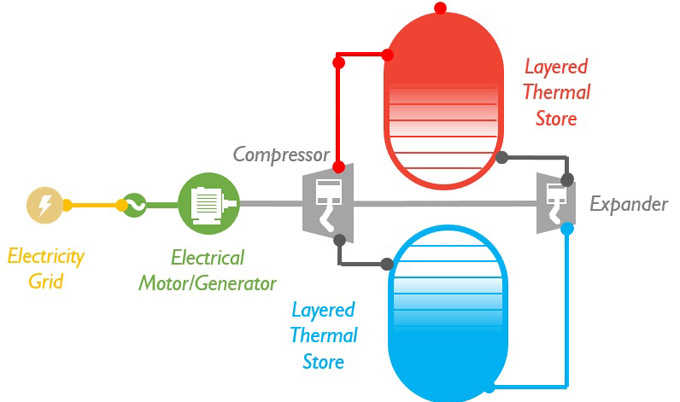Isentropic
Hot rock solution to grid-scale energy storage
Published on: 3 November 2017
Energy Technologies Institute and Newcastle University agree energy storage technology deal to create a new National Facility for Pumped Heat Energy Storage.
Newcastle University has won a bid to lead a major new research centre developing the energy storage technology of the future.
An innovative facility that uses the temperature difference between hot and cold rocks to store energy is being launched as part of a major new research centre led by Newcastle University.
The new National Facility for Pumped Heat Energy Storage will bring together the former Isentropic facility and Newcastle University’s Sir Joseph Swan Centre for Energy Research to create “the world’s first grid-scale demonstration of pumped heat storage”.

How it works
Coupled to the electricity grid, the demonstration facility includes a first-of-a-kind 150kW heat pump, or generator, and uses an innovative reversible heat pump engine which converts electrical energy to heat.
Taking excess electricity from the grid, the system turns the heat pump converting electricity to thermal energy.
On the hot side, a working argon gas is compressed until it reaches 500oC. On the cold side, argon gas is expanded down to a temperature of -160oC.
In both cases, the gas is then passed through ‘thermal batteries’ – chambers containing rocks – and gives up its energy to the storage material, the gas then leaves the store at ambient temperature. What is left behind is a ‘hot rock battery’ and a ‘cryogenic cold battery’, both of which are able to store their energy for up to eight hours.
To release the energy that is stored in the rocks, the process is reversed; the argon gas flows in the opposite direction, providing heating or cooling or used to generate electricity that can be returned to the grid.
Based in Fareham, Hampshire, the £15m facility is set to become a major testbed for future energy solutions and sustainable development.
Decarbonising the grid
Dr Andrew Smallbone, based at Newcastle University’s Sir Joseph Swan Centre for Energy Research and leading the project, explained:
“There are lots of people around the world talking about an energy storage systems but ours will be the world’s first grid-scale demonstration of pumped heat energy storage which is very exciting.
“This technology works much like a battery but at grid-scale it is much cheaper, more sustainable and more efficient than the chemical systems that are currently planned. It also does away with the need for the hazardous and scarce materials associated with most battery technologies.
“Additionally, heat and cold are what we use most of our energy for anyway, so users get to choose the form of the energy released from the battery depending on their needs.
“The next few months will be spent plugging it into the National Grid to demonstrate how a system like this could work in the real world.”
As we move to decarbonise the grid, energy networks of the future will contain a higher proportion of energy from renewable sources.
But renewable energy resources are intermittent so energy storage will be crucial if we are to ensure a constant supply of energy on demand.
Grid-scale energy storage is considered key to ensuring that future renewable energy supplies meet the demands of a 21st century economy.
As a result, the UK’s National Grid is planning to almost quadruple total electrical energy storage capacity by 2030.
“Worldwide, 99% of electricity storage is large, grid-scale Pumped Hydropower,” explains Dr Smallbone.
“By its very nature, it is geographically restricted, but it does set the benchmark for the unit cost of electricity storage. Batteries are another established method, delivering solutions at much smaller scales and deployable anywhere. However even in 2030, the unit cost will still be prohibitive and between 33% - 66% more expensive than Pumped Hydropower.
“Pumped heat energy storage has a very low unit cost of electricity storage – similar to Pumped Hydropower - but with the advantage of being deployable almost anywhere. In addition, it offers the opportunity for on-demand, localised distribution of low-cost, high-grade heat and cryogenic thermal energy.”
Newcastle leading the way in energy research
The University has taken on both the lease of Isentropic’s facility in Fareham and the key engineers. Newcastle University are now focused on the commissioning and testing of the assembled main operational rig as the first milestone of a major test and research programme. Newcastle’s work will be a continuation but independent of the work initiated by the Energy Technologies Institute as part of its Energy Storage and Distribution technology programme.
The University and the ETI are now collaborating to engage interested parties from the industrial and investment sectors in the commercialisation and research programme.
In May of this year, Universities and Science Minister Jo Johnson announced a £20m EPSRC National Centre for Energy System Integration led by Newcastle University which will focus on meeting the challenge of storing new sources of energy to meet future demand.
The work undertaken to date on the ETI project will help inform and contribute to the work of the new centre. EPSRC, one of the ETI’s funding members has helped to facilitate the deal.
Commenting on the deal, Jonathan Wills, Chief Executive Officer of the ETI said:
“Whilst our intention was to fund and deliver the project with Isentropic, we are pleased to see this deal agreed which will continue the work that has been started.
“With even greater volumes of intermittent renewable energy generation being introduced to the UK energy system in the future, there is a need to produce energy storage technology that allows the country to take advantage of its generation capacity, but more importantly deliver it to consumers as and when they require it.
“We had identified the Isentropic technology as providing a potentially cost leading local grid-scale solution. We are very pleased that Newcastle University will now take this technology forward into what we hope is a new viable low carbon proposition from the UK’s globally leading research base.”



